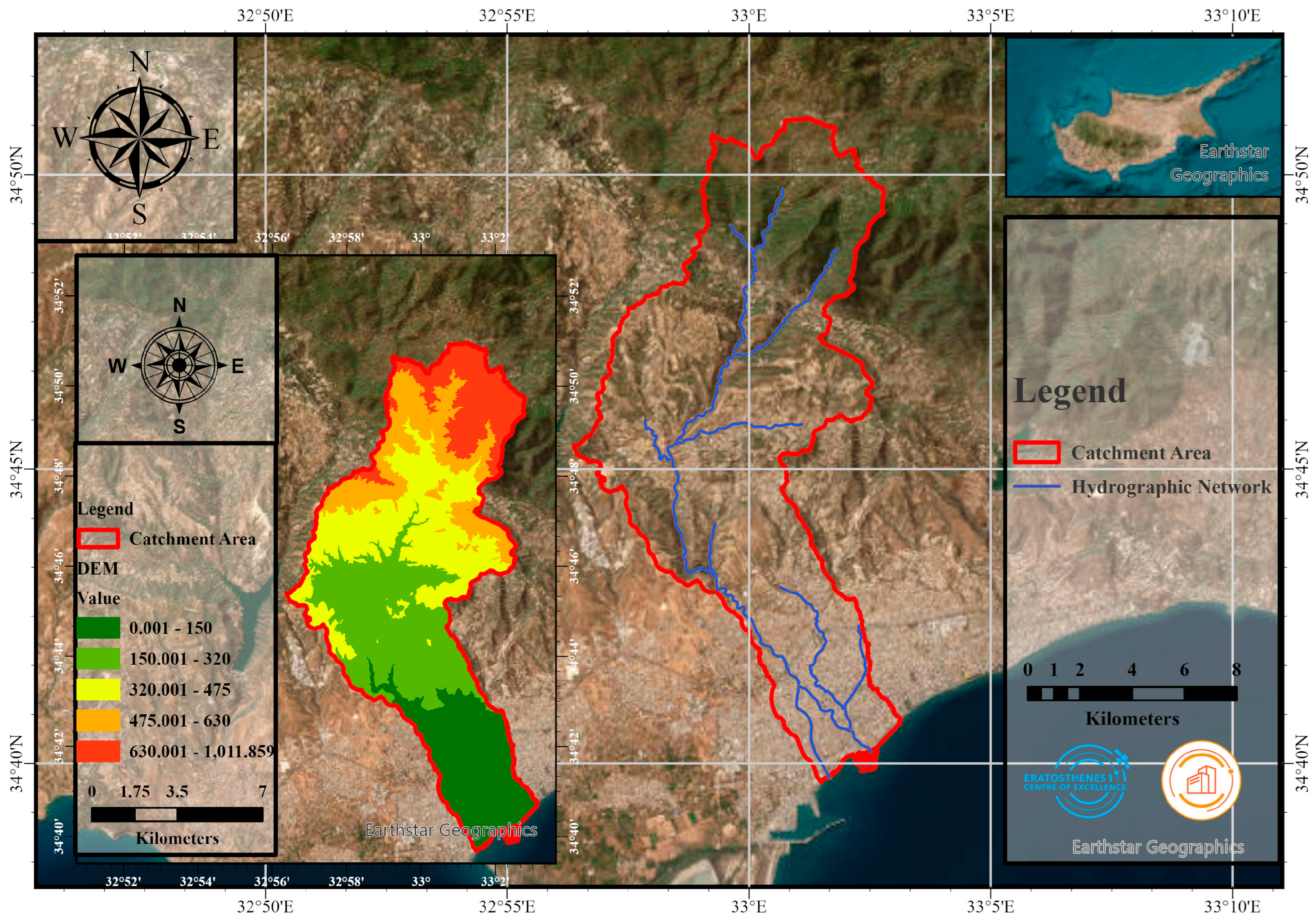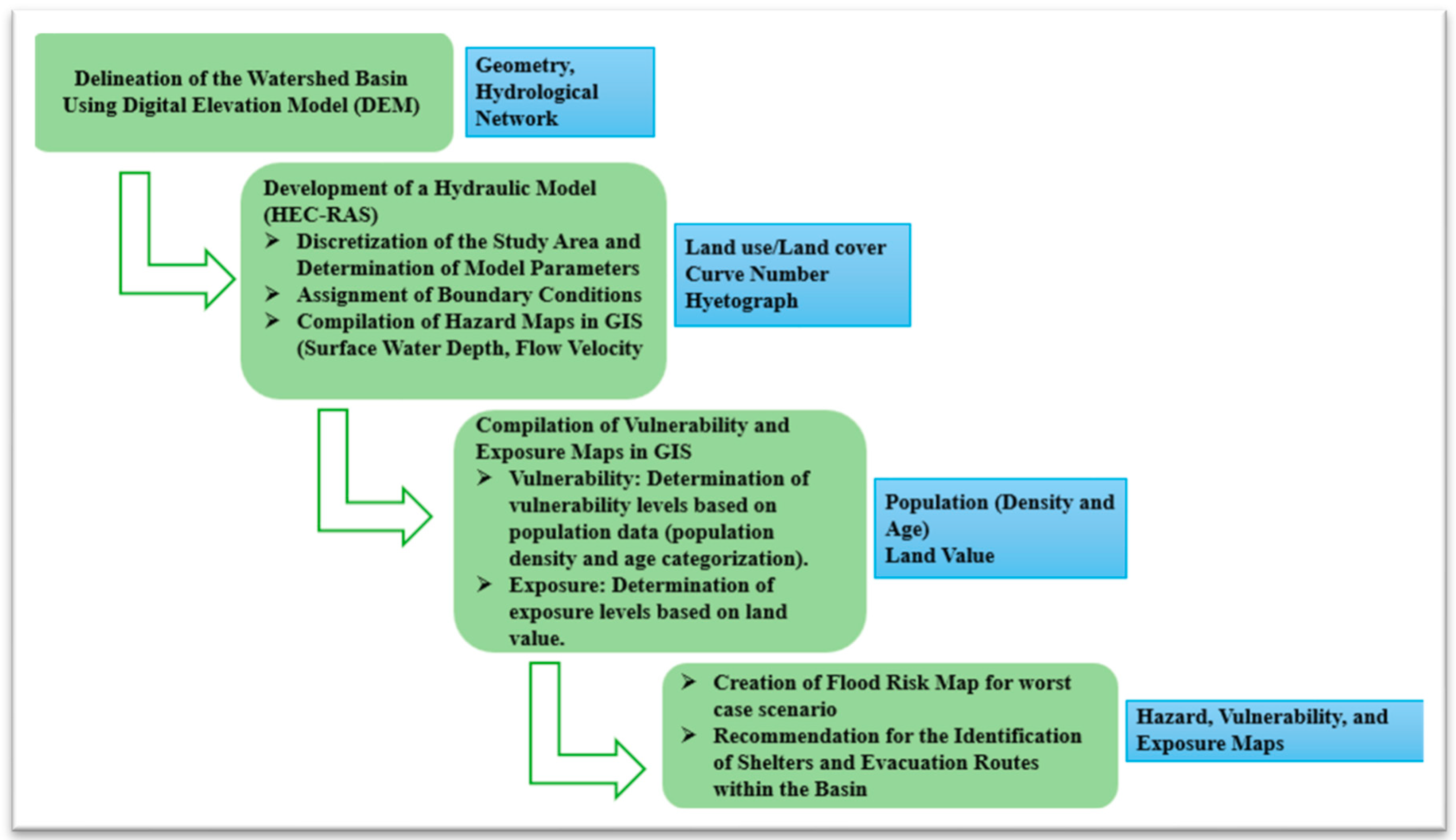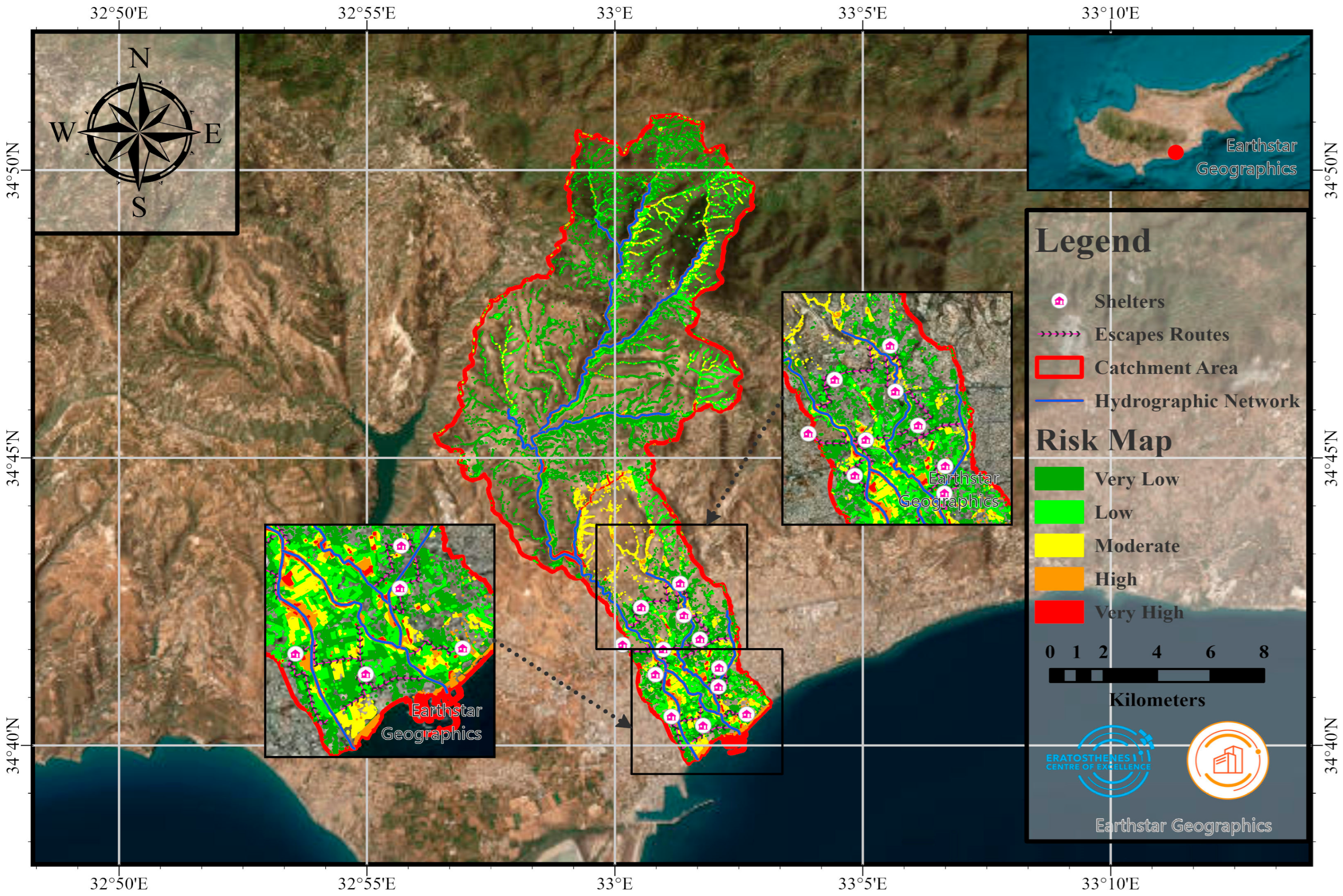A Multidimensional Framework for Flood Risk Analysis in the Garyllis Catchment, Cyprus †
Abstract
1. Introduction
2. Study Area and Data
3. Methodology
4. Preliminary Results and Discussion
5. Conclusions
Author Contributions
Funding
Institutional Review Board Statement
Informed Consent Statement
Data Availability Statement
Acknowledgments
Conflicts of Interest
References
- Ramly, S.; Tahir, W. Application of HEC-GeoHMS and HEC-HMS as Rainfall–Runoff Model for Flood Simulation. In Proceedings of the International Symposium on Flood Research and Management 2015, Shah Alam, Malaysia, 5–7 October 2015. [Google Scholar]
- Guha-Sapir, D.; Hoyois, P.; Below, R. Annual Disaster Statistical Review 2015: The Numbers and Trends. Available online: https://www.cred.be/sites/default/files/ADSR_2015.pdf (accessed on 20 June 2025).
- Statista. Statista—The Statistics Portal. Available online: https://www.statista.com/ (accessed on 13 June 2025).
- Ballester, J.; Quijal-Zamorano, M.; Turrubiates, R.F.M.; Pegenaute, F.; Herrmann, F.R.; Robine, J.M.; Basagaña, X.; Tonne, C.; Antó, J.M.; Achebak, H. Heat-related mortality in Europe during the summer of 2022. Nat. Med. 2023, 29, 1857–1866. [Google Scholar] [CrossRef] [PubMed]
- Derdour, A.; Bouanani, A.; Babahamed, K. Modelling rainfall runoff relations using HEC-HMS in a semi-arid region: Case study in Ain Sefra watershed, Ksour Mountains (SW Algeria). J. Water Land Dev. 2018, 36, 45–55. [Google Scholar] [CrossRef]
- Abdessamed, D.; Abderrazak, B. Coupling HEC-RAS and HEC-HMS in rainfall–runoff modeling and evaluating floodplain inundation maps in arid environments: Case study of Ain Sefra city, Ksour Mountain. SW of Algeria. Environ. Earth Sci. 2019, 78, 586. [Google Scholar] [CrossRef]
- Sett, D.; Trinh, T.P.; Wasim, T.; Ortiz-Vargas, A.; Nguyen, D.G.C.; Büche, K.; Assmann, A.; Nguyen, H.K.L.; Walz, Y.; Souvignet, M.; et al. Advancing understanding of the complex nature of flood risks to inform comprehensive risk management: Findings from an urban region in Central Vietnam. Int. J. Disaster Risk Reduct. 2024, 110, 104652. [Google Scholar] [CrossRef]
- Madsen, H.; Lawrence, D.; Lang, M.; Martinkova, M.; Kjeldsen, T. Review of trend analysis and climate change projections of extreme precipitation and floods in Europe. J. Hydrol. 2014, 519, 3634–3650. [Google Scholar] [CrossRef]
- Panagiotou, C.F.; Feloni, E.; Aristidou, K.; Eliades, M. Probabilistic Assessment of Flood Susceptibility via a Coparticipative Multicriteria Decision Analysis. Environ. Process. 2025, 12, 1–24. [Google Scholar] [CrossRef]
- Panagiotou, C.F. Copula-based assessment of flood susceptibility in the island of Cyprus via stochastic multicriteria decision analysis. Sci. Total Environ. 2025, 979, 179469. [Google Scholar] [CrossRef] [PubMed]
- Mojaddadi, H.; Pradhan, B.; Nampak, H.; Ahmad, N.; Ghazali, A.H.B. Ensemble machine-learning-based geospatial approach for flood risk assessment using multi-sensor remote-sensing data and GIS. Geomat. Nat. Hazards Risk 2017, 8, 1080–1102. [Google Scholar] [CrossRef]
- Tamiru, H.; Wagari, M. Machine-learning and HEC-RAS integrated models for flood inundation mapping in Baro River Basin, Ethiopia. Model. Earth Syst. Environ. 2021, 8, 2291–2303. [Google Scholar] [CrossRef]
- Abu-Abdullah, M.M.; Youssef, A.M.; Maerz, N.H.; Abu-AlFadail, E.; Al-Harbi, H.M.; Al-Saadi, N.S. A Flood Risk Management Program of Wadi Baysh Dam on the Downstream Area: An Integration of Hydrologic and Hydraulic Models, Jizan Region, KSA. Sustainability 2020, 12, 1069. [Google Scholar] [CrossRef]
- Kountouri, J.; Panagiotou, C.F.; Tsouni, A.; Sigourou, S.; Pagana, V.; Loulli, E.; Evagorou, E.; Mettas, C.; Kontoes, C.; Hadjimitsis, D. Flood hazard assessment using HEC-RAS mapping in Garyllis river basin, Cyprus. In Proceedings of the Institute of Electrical and Electronics Engineers (IEEE), Athens, Greece, 7–12 July 2024; pp. 3194–3198. [Google Scholar]
- Sajjad, A.; Lu, J.; Chen, X.; Yousaf, S.; Mazhar, N.; Shuja, S. Flood hazard assessment in Chenab River basin using hydraulic simulation modeling and remote sensing. Nat. Hazards 2024, 120, 7679–7700. [Google Scholar] [CrossRef]
- Wang, X.; Xie, H. A Review on Applications of Remote Sensing and Geographic Information Systems (GIS) in Water Resources and Flood Risk Management. Water 2018, 10, 608. [Google Scholar] [CrossRef]
- Natarajan, S.; Radhakrishnan, N. An Integrated Hydrologic and Hydraulic Flood Modeling Study for a Medium-Sized Ungauged Urban Catchment Area: A Case Study of Tiruchirappalli City Using HEC-HMS and HEC-RAS. J. Inst. Eng. (India) Ser. A 2020, 101, 381–398. [Google Scholar] [CrossRef]
- Kountouri, J.O.; Sigourou, S.; Pagana, V.; Tsouni, A.; Panagiotou, C.; Mettas, C.; Evagorou, E.; Kontoes, C.; Hadjimitsis, D. Flood hazard assessment using HEC-RAS mapping in Garyllis river basin, Cyprus. In Proceedings of the Tenth International Conference on Remote Sensing and Geoinformation of the Environment (RSCy2024), Paphos, Cyprus, 8–9 April 2024; p. 32. [Google Scholar]
- Meresa, H. Modelling of river flow in ungauged catchment using remote sensing data: Application of the empirical (SCS-CN), Artificial Neural Network (ANN) and Hydrological Model (HEC-HMS). Model. Earth Syst. Environ. 2018, 5, 257–273. [Google Scholar] [CrossRef]
- Natarajan, S.; Radhakrishnan, N. Simulation of extreme event-based rainfall–runoff process of an urban catchment area using HEC-HMS. Model. Earth Syst. Environ. 2019, 5, 1867–1881. [Google Scholar] [CrossRef]
- Awad, A.M. Hydraulic Model Development using HEC-RAS and Determination of Manning Roughness Value for Shatt Al-Rumaith. Muthanna J. Eng. Technol. (MJET) 2016, 4, 9–13. [Google Scholar] [CrossRef]
- H. E. C. (HEC) U.S. Army Corps of Engineers. HEC-RAS River Analysis System HEC-RAS User’s Manual. U.S. Army Corps of Engineers, Davis, California, Dec. 2023. Available online: https://www.hec.usace.army.mil/software/hec-ras/documentation.aspx (accessed on 16 June 2025).
- Khattak, M.S.; Anwar, F.; Saeed, T.U.; Sharif, M.; Sheraz, K.; Ahmed, A. Floodplain Mapping Using HEC-RAS and ArcGIS: A Case Study of Kabul River. Arab. J. Sci. Eng. 2015, 41, 1375–1390. [Google Scholar] [CrossRef]
- Khalil, U.; Khan, N.M. Assessment of Flood Using Geospatial Technique for Indus River Reach: Chashma-Taunsa. Sci. Int. 2015, 27, 1985–1991. [Google Scholar]
- Salajegheh, A.; Bakhshaei, M.; Chavoshi, S.; Keshtkar, A.R.; Hajivar, M.N. Floodplain mapping using HEC-RAS and GIS in semi-arid regions of Iran. Desert 2009, 14, 83–93. [Google Scholar]
- Islam, M.; Ujiie, K.; Noguchi, R.; Ahamed, T. Flash flood-induced vulnerability and need assessment of wetlands using remote sensing, GIS, and econometric models. Remote Sens. Appl. Soc. Environ. 2022, 25, 100692. [Google Scholar] [CrossRef]
- Rahmati, O.; Pourghasemi, H.R.; Melesse, A.M. Application of GIS-based data driven random forest and maximum entropy models for groundwater potential mapping: A case study at Mehran Region, Iran. CATENA 2016, 137, 360–372. [Google Scholar] [CrossRef]
- Tsouni, A.; Sigourou, S.; Dimitriadis, P.; Pagana, V.; Iliopoulou, T.; Sargentis, G.-F.; Ioannidis, R.; Chardavellas, E.; Dimitrakopoulou, D.; Mamasis, N.; et al. Multi-parameter flood risk assessment towards efficient flood management in highly dense urban river basins in the Region of Attica, Greece. In Proceedings of the EGU23, the 25th EGU General Assembly, Vienna, Austria, 23–28 April 2023. [Google Scholar]
- Tsouni, A.; Sigourou, S.; Pagana, V.; Tsoutsos, M.-C.; Dimitriadis, P.; Sargentis, G.-F.; Iliopoulou, T.; Ioannidis, R.; Dimitrakopoulou, D.; Chardavellas, E.; et al. Multi-Parameter Flood Risk Assessment and Management Planning at High Spatial Resolution in the Region of Attica, Greece. In Proceedings of the IGARSS 2024—2024 IEEE International Geoscience and Remote Sensing Symposium, Athens, Greece, 7–12 July 2024; pp. 1481–1485. [Google Scholar] [CrossRef]
- Urban Atlas—European Commission Copernicus Land Monitoring Service (CLMS). European Commission. Available online: https://land.copernicus.eu/en/products/urban-atlas (accessed on 16 June 2025).
- Cyprus Civil Defence, CUT, NCSR Demokritos, OC, and CERIDES. National Risk Assessment for the Republic of Cyprus (NRA-CY). 2018. Available online: https://www.moi.gov.cy/MOI/CD/cd.nsf/All/1D4A8C4AE68591AAC2258589003088E7?OpenDocument (accessed on 20 June 2025).
- Εν αναμονή της υπερχείλισης του φράγματος Πολεμιδιών. Reporter. Available online: https://reporter.com.cy/article/2019/1/17/212103/kalei-se-deuteres-skepseis-tous-mathetes-o-khampiaoures-enokhlemene-e-psem-me-ta-megala-diagonismata/ (accessed on 20 June 2025).
- Υπερχείλισε και ο υδατοφράκτης Πολεμιδιών. Καθημερινή Κύπρου. Available online: https://www.kathimerini.com.cy/gr/kypros/yperxeilise-kai-o-ydatofraktis-polemidiwn (accessed on 20 June 2025).
- Copernicus Emergency Management Service—Forest Fire Module (CEMS) European Commission. Available online: https://forest-fire.emergency.copernicus.eu/ (accessed on 11 February 2025).



| Data | Information | Resources |
|---|---|---|
| DEM | 5 m resolution | Department of Lands and Surveys, Cyprus DLS Portal (moi.gov.cy) |
| Road Network | 2016 | Department of Lands and Surveys, Cyprus DLS Portal (moi.gov.cy) |
| Rainfall timeseries | 2011–2023 | Meteorological Department of Cyprus Home Page|Department of Meteorology (moa.gov.cy) |
| Intensity-duration-frequency (IDF) curve | Kalo-horio station | Meteorological Department of Cyprus Home Page|Department of Meteorology (moa.gov.cy) |
| Discharge and water level time series | 1980–2023 | Water Development Department of Cyprus Water Development Department|Home Page (moa.gov.cy) |
| Hydrological network | - | Water Development Department of Cyprus Water Development Department|Home Page (moa.gov.cy) |
| Land use/land Cover | 2018 | Copernicus Land Monitoring Service (CLMS), Urban Atlas Land Cover/Land Use 2018 (vector), Europe, 6-yearly—Copernicus Land Monitoring Service |
| Population | 2011 | Statistical Service Στατιστική Υπηρεσία—Aρχική (cystat.gov.cy) |
| Runoff Curve Number (CN) | 2009 | Water Development Department of Cyprus Water Development Department|Home Page (moa.gov.cy) |
| Land Value | 2021 | Department of Lands and Surveys, Cyprus DLS Portal (moi.gov.cy) |
Disclaimer/Publisher’s Note: The statements, opinions and data contained in all publications are solely those of the individual author(s) and contributor(s) and not of MDPI and/or the editor(s). MDPI and/or the editor(s) disclaim responsibility for any injury to people or property resulting from any ideas, methods, instructions or products referred to in the content. |
© 2025 by the authors. Licensee MDPI, Basel, Switzerland. This article is an open access article distributed under the terms and conditions of the Creative Commons Attribution (CC BY) license (https://creativecommons.org/licenses/by/4.0/).
Share and Cite
Kountouri, J.; Panagiotou, C.F.; Tsouni, A.; Sigourou, S.; Pagana, V.; Kontoes, C.; Danezis, C.; Hadjimitsis, D. A Multidimensional Framework for Flood Risk Analysis in the Garyllis Catchment, Cyprus. Environ. Earth Sci. Proc. 2025, 35, 74. https://doi.org/10.3390/eesp2025035074
Kountouri J, Panagiotou CF, Tsouni A, Sigourou S, Pagana V, Kontoes C, Danezis C, Hadjimitsis D. A Multidimensional Framework for Flood Risk Analysis in the Garyllis Catchment, Cyprus. Environmental and Earth Sciences Proceedings. 2025; 35(1):74. https://doi.org/10.3390/eesp2025035074
Chicago/Turabian StyleKountouri, Josefina, Constantinos F. Panagiotou, Alexia Tsouni, Stavroula Sigourou, Vasiliki Pagana, Charalampos (Haris) Kontoes, Chris Danezis, and Diofantos Hadjimitsis. 2025. "A Multidimensional Framework for Flood Risk Analysis in the Garyllis Catchment, Cyprus" Environmental and Earth Sciences Proceedings 35, no. 1: 74. https://doi.org/10.3390/eesp2025035074
APA StyleKountouri, J., Panagiotou, C. F., Tsouni, A., Sigourou, S., Pagana, V., Kontoes, C., Danezis, C., & Hadjimitsis, D. (2025). A Multidimensional Framework for Flood Risk Analysis in the Garyllis Catchment, Cyprus. Environmental and Earth Sciences Proceedings, 35(1), 74. https://doi.org/10.3390/eesp2025035074







